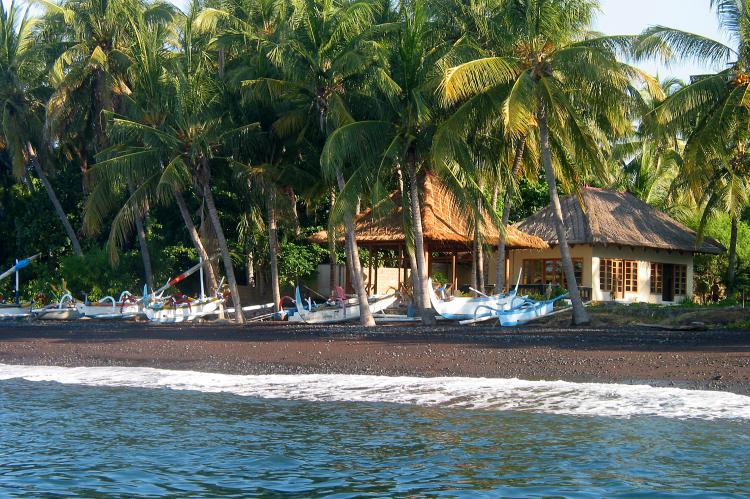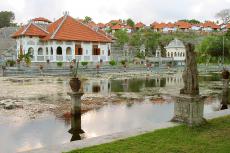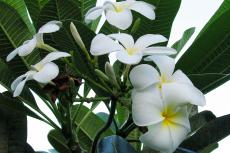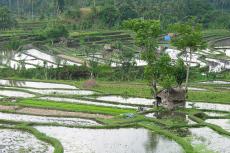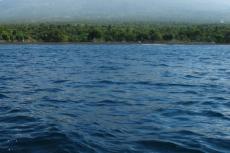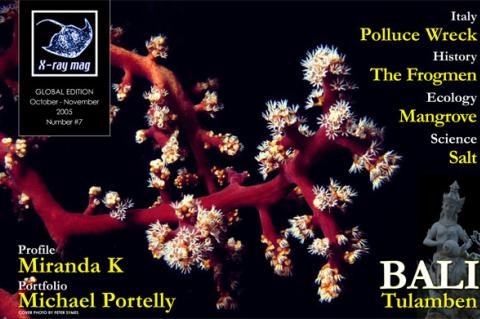Bali
Dark grey!
Usually a colour associated with dull. Not here. The dark lava sand creates a perfect neutral backdrop to make all the colours of corals and critters stand out beautifully. It also dampens the often harsh and bleaching tropical sunlight into something of a less eye-squinting exercise to enjoy.
Tags & Taxonomy
Tulamben
Admittedly, in some overcrowded places, the reefs can be as worn as the grass in a park after a rock concert. But mostly, these areas provide you with constant round-the-clock access to a location. You get to know and learn where to find all the small critters. It gives you the chance to get comfortable with the surroundings and establish a work process. You can always come back and shoot some more film, redo a shot in another fashion, do various experiments and be a little creative. Well, those were my thoughts about it anyway, although I also fancy seeing the variety and different locations to cover the whole spectrum Tulamben proved to provide
us with ample opportunities to do both.
It is a site that holds quite a reputation among dive aficionados. Once we were on location ourselves, it was obvious why. It is said that it is the single best place in Bali to find rare and unusual animals. Even on my first acclimatisation dive, I saw three different varieties, or species, of sea horses, half a dozen different nudibranchs and numerous juvenile paper frogfish, gobies and blennies. The house reef, Seraya Secrets, is the perfect place for macro-photographers and naturalists because it never runs out of surprises, and it is so easily accessible right there in front of the resort. It starts with a shallow plateau where we could often find many different species of scorpionfish willingly posing for our lenses, or perhaps just trusting their camouflage to hide them from us.
Some 15-20m from the beach, the bottom starts to slope down more abruptly, so it is easy to get down to a depth of 25-30m quite quickly. The depth gauge is something that needs to be observed closely here. It seems easy to get carried away with all the marine life and end up going quite deep. The light is beautiful down here too.
In the first few days, we had a bit of an unusual swell that stirred up particles in the top layers, which created a matte filter of blue-grayish light that added a magical romantic touch to the sub-sea landscape.
The coastline looks towards the northeast, which means that light late in the afternoon will arrive from behind the slope. It brings out all the sculptural structures in the lava and the corals. Once back topside, I couldn’t help contemplate how a dive location obtains its fame. This location, as such, is somewhat unassuming and doesn’t immediately stand out in comparison with so many other pretty locations on the planet or island.
No offense—the resorts here are very nice, comfortable and intimate and provide for a very enjoyable and relaxing get-away. Seemingly endless coastlines extend into the horizon. So why here, three hours away from the main tourist areas around Denpasar and Nusa Dua?
Liberty Wreck
One reason could be the Liberty wreck, one of the main dive attractions in the Tulamben area, and certainly one that holds fame beyond Bali.
This 120m wreck is said to be one of the easiest to dive, and sure enough, it lies just off the beach and a very short 35m swim from the coastline. It is lying on its starboard side parallel to the beach with the keel pointing towards the coast. It lies port side and some of the twisted superstructure seems to be just below the surface. The wreck is indeed very nice because it is so accessible and covered with interesting growth. It is a good hiding place for a wide variety of sea life. As a wreck for wreck fanatics, it is probably less interesting as, for one, there are no artefacts to recover.
WW2
It is a WWII wreck indeed. It was a casualty of a Japanese torpedo. But the wreck actually first sat on the beach for more than 20 years, during which period everything worthwhile salvaging, including her propeller was removed. The Liberty, not to be confused with a Liberty class vessel, was a cargo ship carrying rubber and railroad parts from Australia to the Allied forces in the Philippines, when she was struck by a torpedo in the nearby Lombok strait on January 11, 1942.
Two US destroyers took her on tow towards Singaraya hoping she could be repaired, but she was fatally wounded and took on too much water. She was then beached at Tulamben in an effort to keep her from sinking, but there was no time to salvage her cargo before the Japanese invaded Bali. She then sat here for over two decades until 1963 when Bali’s highest mountain and volcano erupted violently and created earth quakes that rolled the ship off the beach and broke the hull in several pieces. It is no longer advisable to penetrate the wreck as it is starting to break up, and the steel is very fragile in places. But is still a haven to go look for creatures.
Its tiny!
On my first dive I even caught a glimpse of the
elusive pygmy sea horse. This was my first sighting of the species, and I was absolutely taken aback. I could not believe how small it was. Amazing... and truly pygmy, indeed. No wonder that they were only discovered in recent years.
We started the dive off the stern, which was decorated with majestic fan corals, and to the right, we saw the stern gun that was hastily retrofitted to the Liberty. This wreck is like the gardens of Babylon as regards to fan corals and other hanging or
(...)
Download the full article ⬇︎
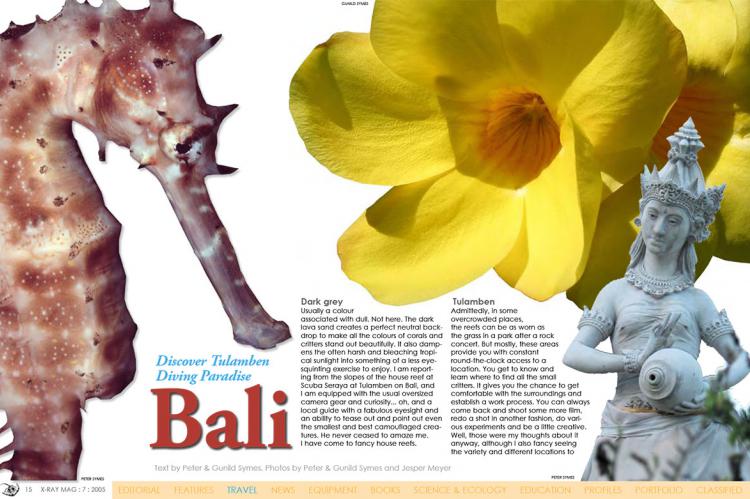
Originally published
X-Ray Mag #7
BALI - visiting Tulamben. Science: Salt of the sea. Conservation: Mangrove. Polluce wreck. The first frogment. The Techni-sub story. Royal Tasmania. Portfolio: A tribute to Michael Portelly. Technical matters: Going solo or not? Photography: Manipulation? Ecology: Anemone city Profile: Miranda Krestovnikoff. Science: Drinking seawater


